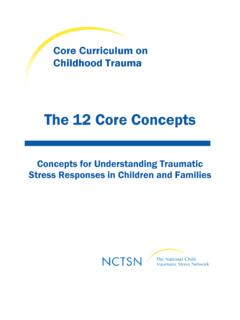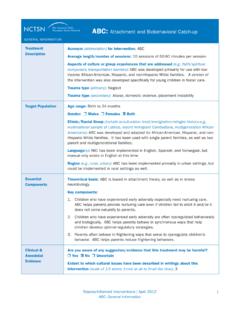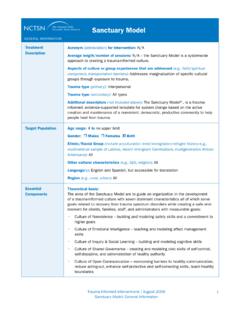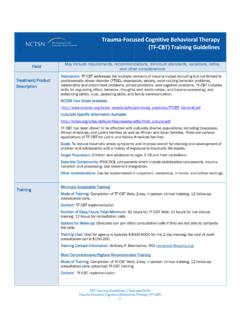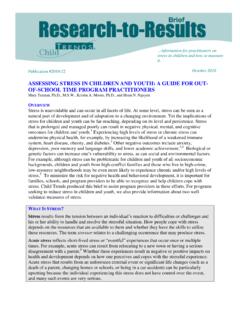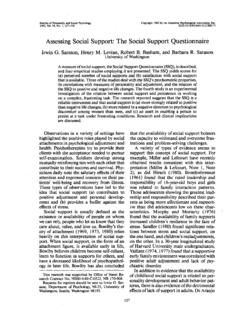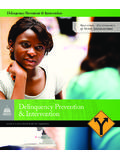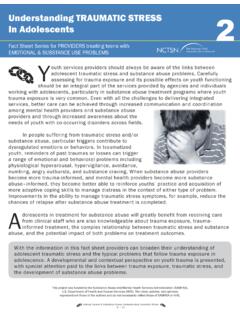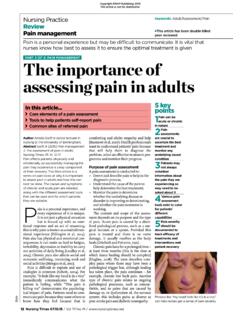Transcription of Secondary Traumatic Stress
1 We are stewards not just of those who allow us into their lives but of our own capacity to . be Secondary Traumatic Stress A Fact Sheet for Child-Serving Professionals INTRODUCTION. TABLE OF CONTENTS. Each year more than 10 million children in the United States endure the trauma 1. of abuse, violence, natural disasters, and other adverse These experi- ences can give rise to significant emotional and behavioral problems that can SECTION ONE: profoundly disrupt the children's lives and bring them in contact with child-serv- How Individuals Experience ing systems. For therapists, child welfare workers, case managers, and other Secondary Traumatic Stress ?..2. helping professionals involved in the care of traumatized children and their SECTION TWO: families, the essential act of listening to trauma stories may take an emotional Understanding Who is at toll that compromises professional functioning and diminishes quality of life.
2 Individual and supervisory awareness of the impact of this indirect trauma ex- SECTION THREE: posure referred to as Secondary Traumatic Stress is a basic part of protecting Identifying Secondary Traumatic Stress ..3. the health of the worker and ensuring that children consistently receive the best SECTION FOUR: possible care from those who are committed to helping them. Strategies for Our main goal in preparing this fact sheet is to provide a concise overview of SECTION FIVE: Strategies for Secondary Traumatic Stress and its potential impact on child-serving profession- als. We also outline options for assessment, prevention, and interventions rele- SECTION SIX: vant to Secondary Stress , and describe the elements necessary for transforming Worker Resiliency in Trauma-informed child-serving organizations and agencies into systems that also support worker Systems: Essential resiliency.
3 1. 1 How Individuals Experience Secondary Traumatic Stress Secondary Traumatic Stress is the emotional duress that results when an indi- Secondary Traumatic Stress vidual hears about the firsthand trauma experiences of another. Its symptoms and Related Conditions: mimic those of post- Traumatic Stress disorder (PTSD). Accordingly, individuals af- Sorting One from Another fected by Secondary Stress may find themselves re-experiencing personal trauma or notice an increase in arousal and avoidance reactions related to the indirect trauma exposure. They may also experience changes in memory and perception; Secondary Traumatic Stress refers to the alterations in their sense of self-efficacy; a depletion of personal resources; and presence of PTSD symptoms caused by at disruption in their perceptions of safety, trust, and independence.
4 A partial list of least one indirect exposure to Traumatic symptoms and conditions associated with Secondary Traumatic Stress includes3 material. Several other terms capture elements of this definition but are not all Hypervigilance interchangeable with it. Hopelessness Inability to embrace complexity Compassion fatigue, a label proposed by Inability to listen, avoidance of clients Figley4 as a less stigmatizing way to de- Anger and cynicism scribe Secondary Traumatic Stress , has Sleeplessness been used interchangeably with that term. Fear Chronic exhaustion Vicarious trauma refers to changes in the inner experience of the therapist Physical ailments resulting from empathic engagement with Minimizing a traumatized It is a theoretical Guilt term that focuses less on trauma symp- toms and more on the covert cognitive Clearly, client care can be compromised if the therapist is emotionally depleted or changes that occur following cumulative cognitively affected by Secondary trauma.
5 Some traumatized professionals, be- exposure to another person's Traumatic lieving they can no longer be of service to their clients, end up leaving their jobs material. The primary symptoms of vicari- or the serving field altogether. Several studies have shown that the development ous trauma are disturbances in the profes- of Secondary Traumatic Stress often predicts that the helping professional will sional's cognitive frame of reference in the eventually leave the field for another type of ,5. areas of trust, safety, control, esteem, and intimacy. 2 Understanding Who is at Risk Burnout is characterized by emotional exhaustion, depersonalization, and a re- duced feeling of personal accomplish- ment. While it is also work-related, burnout The development of Secondary Traumatic Stress is recognized as a common oc- develops as a result of general occupation- cupational hazard for professionals working with traumatized children.
6 Studies al Stress ; the term is not used to describe show that from 6% to 26% of therapists working with traumatized populations,and the effects of indirect trauma exposure up to 50% of child welfare workers, are at high risk of Secondary Traumatic Stress specifically. or the related conditions of PTSD and vicarious trauma. Compassion satisfaction refers to the Any professional who works directly with traumatized children, and is in a po- positive feelings derived from competent sition to hear the recounting of Traumatic experiences, is at risk of Secondary performance as a trauma professional. It is Traumatic Stress . That being said, risk appears to be greater among women and characterized by positive relationships with among individuals who are highly empathetic by nature or have unresolved per- colleagues, and the conviction that one's sonal trauma.
7 Risk is also higher for professionals who carry a heavy caseload of work makes a meaningful contribution to traumatized children; are socially or organizationally isolated; or feel profession- clients and society. ally compromised due to inadequate ,8 Protecting against the develop- ment of Secondary Traumatic Stress are factors such as longer duration of pro- fessional experience, and the use of evidence-based practices in the course of providing 2. 3 Identifying Secondary Traumatic Stress Supervisors and organizational leaders in child-serving systems may utilize a variety of assessment strategies to help them iden- tify and address Secondary Traumatic Stress affecting staff members. The most widely used approaches are informal self-assessment strategies, usually employed in conjunction with formal or infor- mal education for the worker on the impact of Secondary Traumatic Stress .
8 These self-assessment tools, administered in the form of questionnaires, checklists, or scales, help characterize the individu- al's trauma history, emotional relationship with work and the work en- vironment, and symptoms or experiences that may be associated with Traumatic ,9. Supervisors might also assess Secondary Stress as part of a reflective supervision model. This type of supervision fosters professional and personal development within the context of a supervisory relationship. It is attentive to the emotional content of the work at hand and to the professional's responses as they affect interactions with clients. The reflective model promotes greater awareness of the impact of indi- rect trauma exposure, and it can provide a structure for screening for emerging signs of Secondary Traumatic Stress .
9 Moreover, because the model supports consistent attention to Secondary Stress , it gives su- pervisors and managers an ongoing opportunity to develop policy and procedures for Stress -related issues as they arise. Formal assessment of Secondary Traumatic Stress and the related conditions of burnout, compassion fatigue, and compassion satisfaction is often conducted through use of the Professional Quality of Life Measure (ProQOL).7,8,10,11 This questionnaire has been adapted to measure symptoms and behaviors reflective of Secondary Stress . The ProQOL can be used at regular intervals to track changes over time, especially when strategies for prevention or intervention are being tried. 4. Strategies for Prevention PREVENTION. Psychoeducation A multidimensional approach to prevention and intervention involving the Clinical supervision individual, supervisors, and organizational policy will yield the most positive outcomes for those affected by Secondary Traumatic Stress .
10 The most import- Ongoing skills training ant strategy for preventing the development of Secondary Traumatic Stress is the triad of psychoeducation, skills training, and supervision. As workers Informal/formal self-report screening gain knowledge and awareness of the hazards of indirect trauma exposure, they become empowered to explore and utilize prevention strategies to both Workplace self-care groups reduce their risk and increase their resiliency to Secondary Stress . Preventive (for example, yoga or meditation). strategies may include self-report assessments, participation in self-care Creation of a balanced caseload groups in the workplace, caseload balancing, use of flextime scheduling, and use of the self-care accountability buddy system. Proper rest, nutrition, exer- Flextime scheduling cise, and Stress reduction activities are also important in preventing Secondary Traumatic Stress .


